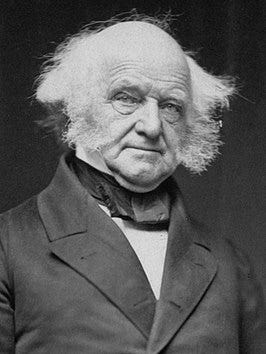It was the best real estate deal ever. In 1624, Peter Minuit bought Manhattan from a group of Native Americans for 26 guilders. On the site, he founded Nieuw Amsterdam. It became a thriving tradepost but in 1664 was captured by the British. The chance of a Dutch United States was lost.
If not for this unfortunate event, I would be writing this blog in Dutch and still reach my global audience :)
The English unjustly renamed the town and called it New York henceforth. Many familiar names derived from Dutch persist until this very day, though, such as Broadway, Flushing Meadows, Brooklyn, Staten Island, Harlem, Wallstreet, and the Bronx.
Too bad for the Americans of today. As I demonstrate in this blog post, had the US remained Dutch, it would be better run by far.
At least one American president spoke Dutch at home and only learned English in school. His wife never learned to speak English without a Dutch accent. Martin van Buuren was president from 1837 to 1841 and was born in the village of Kinderhook, meaning Children’s Corner in Dutch. Couldn’t he at least have made Dutch the national language by executive order?
Now, let’s discuss the most important and unexpected Dutch influence on the United States.
No, it is not Santa Claus, although he is a copy of the Dutch Sinterklaas. Our Santa also has a beard and red clothes, gives presents to children, and has been accused of pedophilia. He has no reindeer, though; he has a mare and walks on rooftops. He arrives from Spain on a steamer (a big televised event every year), which is, let’s face it, a more realistic mode of transportation than a span of reindeer. Despite those differences, it is a clear case of copyright infringement.
Is our most enduring contribution maybe Eddie van Halen? He was born in Amsterdam after all and he and his brother Alex spoke fluent Dutch, as you can hear in this clip (from 0.35). His most famous guitar solo is this one (from 0.40). He invented this style of playing, with hammer-ons. It had a huge influence on rock guitarists, but not on the USA in general.
Our most crucial influence is not on the American vocabulary either, although we generously gave the American language words like cooky, coleslaw, Yankee, iceberg, and kink.
Arguably, the Dutch influence on the Declaration of Independence is the most important.
In 1581, almost 200 years before the American Revolution, the Dutch declared themselves independent from Spain in a document called De Acte van Verlatinghe (the Act of Abjuration, or Secession).
They argued that their sovereign, Philip II, king of Spain, who lived thousands of kilometers away, wanted to take away their God-given rights and tax them unjustly without their consent. Then they founded the Republic of the Seven United Netherlands.
Sounds familiar, doesn’t it?
Like the Dutch, the American colonists argued their sovereign, the English king George II, who lived thousands of kilometers away, wanted to take away their God-given rights and tax them unjustly and without their consent. Then they founded a republic of thirteen states.
There are many similarities between the Declaration of Independence and the Acte van Verlatinghe. Both begin with a preamble that justifies, in a similar fashion, the right of citizens to revolt against tyrannical authority. Both present a long list of grievances as evidence of their king’s tyranny and the repeated attempts of the citizens to seek redress of their complaints through existing legal and civic channels. Ultimately, both documents conclude that having repeatedly been rebuffed by despotic authority, they have no other option than revolution.
Had there been copyright laws back then, Thomas Jefferson and his friends would have been in trouble.






